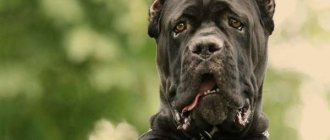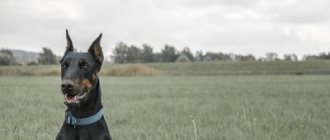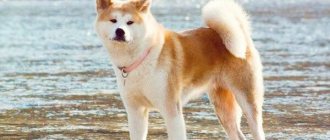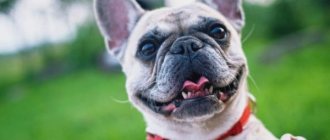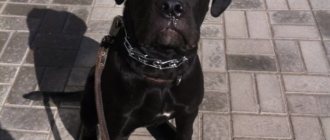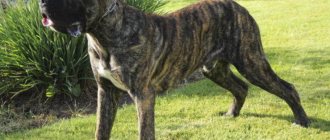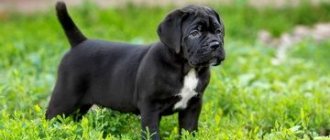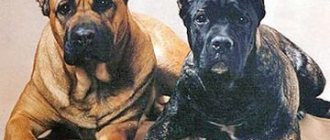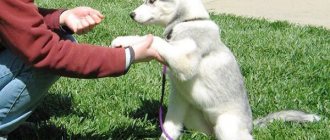Raising a dog is about developing correct behavior. This is the basis for successful training. Training is a set of activities aimed at training specific teams. It is necessary to start raising a puppy from the very first days of his appearance in the house. If you work with your pets from a very early age, then you are on the right track.
The Cane Corso is not just a great friend and protector, he is a real national treasure and the pride of Italy. His character reflected the brightest emotions of temperamental Italians: courage, dedication, strong character, devotion, active life position.
- Country of origin : Italy
- Height at withers : male: 64-68 cm; female: 60-64 cm
- Weight : male: 45-50 kg; female: 40-45 kg
- Lifespan : 10-12 years
- Use : Bodyguard, Companion Dog, Security
- Other names : Italian Mastiff
When to start training a dog
As soon as a Cane Corso puppy appears in your home, immediately begin to build a relationship with him. From the first day it is necessary to provide him with everything he needs: bowls for water and food, collar, leash, bed, suitable food, toys and of course treats. You need to give him a lot of attention so that he feels safe and begins to trust you. From a very early age, a Cane Corso puppy needs to be introduced to commands. In addition, in the first months it is necessary to study commands both at home and on the street. First, the puppy must remember its name. We wrote how to choose a suitable nickname in one of our articles. The name should be short, easy to remember and the dog should be called only by it. When the pet has already mastered its name and finally begins to respond, then we move on to commands. By the 3rd month he should master the following commands: “Ugh!”, “Come to me!”, “Place!”, “Nearby!” and “Fetch!” (optional). Then you can move on to the rest, of course, if you need them.
What can be taught?
By correctly and consistently carrying out all the steps to raise and train a pet, an Akita dog can be taught everything that other trained dogs can do.
First of all, the puppy must be accustomed to the important components of life with a person
- use a diaper to relieve yourself;
- do not bite a person;
- do not be afraid of the collar and leash;
- do not beg for food from the owner’s table or pick it up from the floor;
- treat strangers with respect;
- stop barking on the owner's command;
- follow basic commands “sit”, “stand”, “lie down”;
- understand the command “fu”;
- execute the "nearby" command.
NOTE! Learning certain behaviors and commands occurs gradually; you cannot throw everything at once onto the puppy’s fragile psyche and body.
Features of the Cane Corso breed
Training course required! You should start raising a puppy immediately after purchasing it. Italians are easy to train, but keep in mind that using physical punishment on them is not recommended. Cane Corso dogs must undergo a general training course and, if necessary, behavioral adjustments. Dogs of this breed are excellent at passing OKD and ZKS due to their endurance and intelligence. Do not forget that the Cane Corso is a serious breed of dog and you take full responsibility for its adequacy and good manners. Cane Corso requires physical and mental exercise, long walking twice a day. If you don’t do this, the dog may chew through all the furniture in the house out of boredom.
General training course
The general training course is based on systematic training. The skills developed during the general course form the basis for the formation of conditioned reflexes in the animal.
The first skill is to teach the puppy to go to the toilet only outside. During the learning process, it is necessary to practice instructions with gestures and voice.
https://dog-care.ru/dressirovka/obuchenie/kak-pravilno-dressirovat-kane-korso.html
General skills and abilities include:
- Response to nickname;
- Habit of a collar, leash, harness;
- Approach to the trainer;
- Walking nearby;
- Habit of lying, sitting, standing, crawling positions;
- Ability to follow voice commands, stop certain actions, overcome obstacles;
- Refusal of other people's food;
- Tolerance to noise stimuli.
How to raise a Cane Corso puppy
If you train your pet correctly, then over time you will get an obedient dog that will follow all commands and delight you every day. Experts believe that several factors may influence the Cane Corso’s susceptibility to following various commands:
- pet's temperament - the speed of the pet's reaction to stimuli, both positive and negative;
- character - how exactly the dog resists various unpleasant influences;
- obedience - the dog’s ability to accept human leadership;
- vigilance - the speed with which the dog notices potential danger, both in relation to itself and in relation to the owner;
- aggressiveness - the pet’s ability to react hostilely to potential danger;
- curiosity - interest that is developed when a dog feels, hears and sees something;
- sociability - the ability to interact with people;
- possessiveness is the interest shown by animals in certain objects, for example toys.
How quickly your dog will learn commands depends on which traits predominate in the Cane Corso puppy’s character. By paying attention to the character traits of your animal, you can find an approach to it and adjust its behavior in certain situations.
- Eagerness will get you nowhere . You should not try to teach your Cane Corso puppy all the commands at the same time; you need to learn the commands one by one. You need to have patience and act methodically. You should not scold your pet at the moment when he makes mistakes, and when he succeeds in something, then the pet should be encouraged.
- Don't hit . It is prohibited to use physical punishment against a pet. You should limit yourself to variable intonation, but avoid shouting. After the Cane Corso puppy turns three months old, it is allowed to use a light spank as punishment while saying the phrase “Ugh.” It is necessary to punish immediately when the animal commits an offense, and not after it, since the animal simply will not understand what exactly it was punished for.
- Subsequence . The main goal is to ensure that the pet follows the command the first time. Commands should be pronounced clearly and in an even voice so that the dog understands and obeys you. All family members should be involved in raising the dog, but they must act together. It is forbidden to allow situations in which you scold the puppy, and another family member praises him or simply does not pay attention.
- Pamper . Remember to reward your Cane Corso puppy with a variety of treats and praise when he has done what is asked of him.
Why train
Training a dog at home has 3 goals:
- The pet must recognize the owner as a leader.
- The person will know well how to behave with the pet.
- A trained dog is a socially adapted pet.
The owner must choose whether to use deterrents or rewards for a motivational item.
The greatest impact is achieved when the dog receives praise right away.
Containment methods:
- Using objects that can attract the dog's attention. Things that make sharp sounds - whistles, a bunch of keys, a rattle from a tin can with pebbles, etc.
- If the actions are not followed, the dog loses the owner's attention. She is sent to her place without the usual stroking and praise, in a stern voice.
Pet restraint methods can be used on older puppies older than 4 months. If the dog is unbalanced, then this method should not be used.
Ignoring a pet is a more effective technique than physical influence.
Training is quite a labor-intensive task, but teaching a dog to behave correctly is easier than correcting inappropriate behavior.
Basic commands
You will use some commands more often, others less often. But they will still come in handy to easily interact with the Cane Corso and even keep it safe in various situations.
- Aport. One of the most difficult teams. Many people perceive it as very easy and simple, but with many dogs you will have to work hard. This skill is used for other exercises: searching, searching, selecting an item and many others. Usually they are all used in service. When working out a command, “Aport” and “Give” are used, and a gesture is also used.
- Give. On the command “Give” the dog must give up the object.
- Lie. A connecting command that needs to be learned for other commands. In addition, it will not interfere at home or on the street.
- To me. You will need to use this command quite often. So start with it immediately after your Cane Corso puppy has learned his name. Never call the dog to punish, and do not scold if it comes on its own, even after mischievousness before it. This behavior on your part may alienate the animal.
- Place. A puppy or an adult dog must clearly know where his place is located. He can sleep anywhere, if you allow it, of course, but he must know this command. You can use it outside the home, marking the place with a leash or your favorite toy.
- Near. It is possible to teach your pet the “Near” command at any age, be it an adult dog or a small puppy. When you move to a new home, you should immediately think about training your puppy.
- Sit. One of the very first commands that a Cane Corso puppy should learn.
- Stand. The command is useful in everyday life, for example, for combing a dog.
- . The prohibiting command is one of the most mandatory and taming it begins from the first day the puppy appears in the house. Requiring the command “Fu!”, “No!”, “No!” - immediately stop the unwanted action.
Dog equipment
Starting from 2-2.5 months, the puppy should be accustomed to a collar and leash, and from 8-9 months - to a muzzle.
When choosing ammunition, you should consider some nuances:
- Collar. A soft leather or wicker collar is most suitable for walking. A token with the owner’s address must be placed on it. The collar should not put pressure on the neck, but the dog should not jump out, backing away or pushing. To conduct classes, a training collar-noose is used, which allows you to control the behavior of the animal. If the dog is not obedient enough, you will have to use a strict collar (parfors) with metal spikes. It should be taken into account that constant wearing of parforce leads to addiction and elimination of the desired effect.
- Muzzle. For a large dog this is a necessary piece of equipment. Depending on the age and aggressiveness of the dog, you can choose the following options: a metal mesh, a bridle muzzle, a leather, fabric or plastic muzzle. When choosing them, the following requirements are taken into account: the ability to breathe freely by opening the mouth; opportunity to drink water; light weight; no interference to the eyes; eliminating the possibility of dog bites. Muzzles are selected according to the individual parameters of the animal. The following characteristics are taken into account: the girth of the muzzle and neck, the length of the muzzle to the back of the head, the width and height of the muzzle. The equipment should not greatly interfere with head movement.
- Leash. The main requirement is that it must withstand any jerking from the dog. The leash can be leather, wicker or in the form of a metal chain. The length is at least 2 m.
All equipment for a dog must be selected taking into account its age. As you grow older, you have to update it more than once. It should provide the ability to control the animal’s behavior and eliminate danger to others, while being comfortable enough for the pet itself.
Raising a dog
Education is the process of shaping Cane Corso behavior acceptable to the owner, when this behavior is not regulated by commands.
During upbringing, a dog develops relationships with its owner, family members, passers-by, behavior in the house, on the street, and relationships with other dogs. The training process begins immediately when the dog first appears in the house and continues throughout the dog’s life. Regardless of the dog's breed, it must be trained. Just as people do not like ill-mannered people, dogs should also know what is allowed and what is not allowed. Raising a dog is a rather complex process, which is not limited to learning just a few commands. The main goal of education is that the dog should become pleasant to talk to. In addition, it must be manageable at some points, otherwise it will be very difficult for the dog owner. In the broadest sense of the word, dog training is about teaching the dog commands such as “Bad” and “No”. But besides this, the dog must know what is good and what is bad, even in those moments when the owner is not around. Some people believe that the Cane Corso only understands commands, but cannot generalize. Only those who, as a rule, never had dogs, and studied them only in laboratory conditions, in which dogs were not able to show their full potential, are convinced of this, as well as those who, due to their personal qualities, were unable to establish a relationship with pet. In real life, the Cane Corso is a pack animal and therefore, like any other pack animal, needs to communicate with members of its family. In this situation, the dog’s family members are people. It is quite stupid to think that if a dog caresses you, this means that his skin is itching. In order for a dog’s nervous system to function normally, it needs affection, love, communication, and praise. In addition, so-called “inhibiting factors” are required, because if the dog is allowed everything, then this will not lead to anything good. When raising a Cane Corso puppy, you should pay attention to the genetic characteristics of the breed. A family is a pack in which there must be a leader, in this case the leader is a person. The leader punishes, plays, feeds, caresses, praises and scolds. All other members of the owner's family are ranked by rank. At that moment, while the puppy is small, all other family members are senior to him. However, in the process of growing up, around the age of one year, the dog begins to look for its place in the hierarchical pyramid. Naturally, she will try to take the step that is as high as possible. She can do this with the help of force, in the case of large dogs, or with the help of cunning, as small dogs do. The more ill-mannered the dog is, the more difficult this process will be. If the owner from the first days shows his pet that the one who has the power is right, then he will turn out to be a frail neurotic or an evil beast with whom you will hardly communicate with joy. A Cane Corso puppy must understand that he must obey people, since they love him, feed him, and raise him. Understand that prohibitions are not the whim of the owner, but a way to protect everyone from trouble. The main influence on the dog should be the voice. From the first days of being in your home, the puppy must realize that you love him, and if you raise your voice, then this means that he is doing something wrong. One of the best incentives for a pet is considered to be a treat, which should be given out for good behavior and listening to commands. Training and education of the Cane Corso
Toilet training
To toilet train a dog, you need to be patient. You will need it if you want to properly raise your Cane Corso in general. First of all, you need to remove materials from your apartment that absorb dog urine well: carpets and linoleums pose the greatest danger. Such surfaces most easily retain the smell of urine and, accordingly, attract Cane Corsos again and again.
The puppy needs to be provided with a separate place for the toilet. You can place the toilet in the place that the dog most often chooses to defecate. As a rule, these are located near the balcony, under the window or in the corner of the corridor. If the puppy ignores the place, use Antipis. The smell of a product based on plant essential oils will repel the animal. Accordingly, it will stop spoiling the floor in undesirable places.
"Place" indication
Command “Place” and entice him with a treat. On the lounger, praise and give a piece.
Gradually increase the time between arrival and reward, and then give treats occasionally. In everyday life, the “Place” command is used when a pet behaves badly (for example, begging from the table or jumping on guests).
By giving the "Place" command, you tell the dog exactly where he needs to go. They quickly grasp the meaning of this command and leave offended.
If he pesters you, then you need to command “Place” again in a more menacing tone.
Before teaching the “Place” command, make sure that the dog knows the “Lie” and “Come” commands.
Step 1: Place him on a long leash and make him lie down.
Step 2. Place a large item, such as a backpack, next to it. Do not use someone else's things or his things (muzzle, toy or bowl).
Step 3. Repeat the “Down” command to him and move away 5 steps.
Step 4: Wait 3 seconds and then command “Come.” When he approaches you, praise him.
Step 5. Give the “Place” command by pointing your hand at the backpack. Move towards the thing, but don't pull on the leash. As you walk, joyfully repeat: “Place. Place".
Step 6. Once in place, command “Down” and give a treat.
Repeat the exercise. Get him to go to the place without your help. Gradually increase the distance and stop using the leash.
The pet must approach the thing lying 15 meters away, lie down and wait (30 seconds) for you to allow it to leave the position. Teach him to stay still when people or animals walk nearby.
If the dog breaks away without a command, bring it back, repeating: “Place.” If the dog refuses to return to its place without you: call the dog left near the thing, sit it next to you and command “Wait.” Then show the dog the treat and go to the “spot” alone. Place it on your backpack and return to the dog. Command “Place”, and if the dog runs up to the thing and lies down, praise it and let it eat a piece.
Common mistakes when training
- The dog is unconscious of its actions and does not understand human speech. When giving a command, you cannot talk; conditioned reflexes are inhibited. All commands are pronounced without further ado.
- Violations of the order of skill development. From simple to complex. Until the dog has mastered a certain command well, you cannot proceed to the next one.
- The dog handler does not take into account the characteristics of the animal, which reduces the effectiveness of training.
- Retraining. Frequently practicing the same skills helps to fatigue, reduce performance and overload the nervous system. Once the technique is learned, it is no longer performed that day. If she refuses to perform a skill as a result of overtraining, then she is given a rest for 2-3 weeks. Dog handlers monitor the condition of the dog during training.
- Incorrect voice intonation changes the sound of the command. You cannot pronounce everything in one intonation, otherwise it loses its significance as an irritant. The dog will stop responding to her.
- Incorrect use of directions. You can’t repeat it often, otherwise you’ll develop the skill of doing it when you repeat it.
